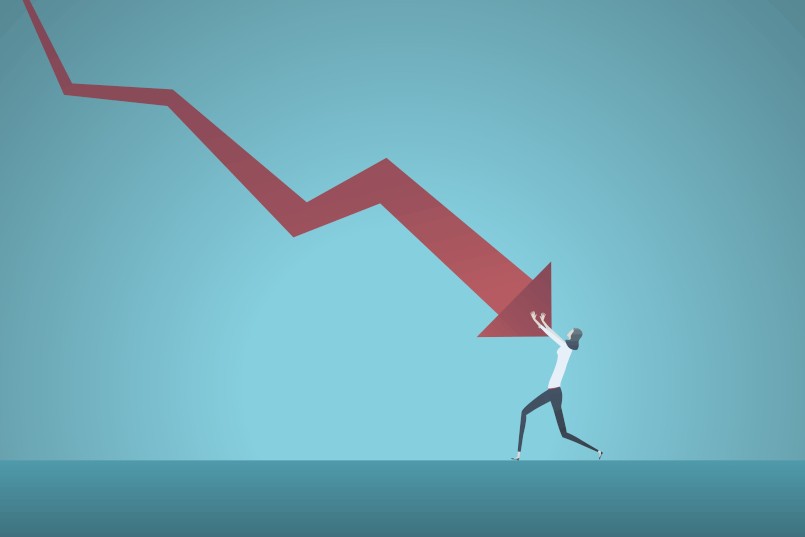We’ve heard about the economic slow-down for a while now. And as I write the stock markets are tumbling into a bear market.
With indicators such as the US/China tariff war, major financial market declines, China’s industrial production growth being at a 30-year low at 4.8% (shifting from manufacturing to services is a long game), and GDP contractions in Germany and the UK, they all point to the fact that we’re more than likely heading into very tough times.
Consumer confidence waning
Westpac’s latest Consumer Sentiment Index declined 3.8% to 91.9 in March 2020, from a score of 95.5 in February. This score is the second lowest result since the GFC in 2008, when it hit 79. Westpac cited coronavirus – or COVID-19 – scares, as well as tough climate and economic conditions as reasons for the slump.
So as the coronavirus spreads, supply chains get disrupted, and more and more cancellations of travel, conferences, and large events occur, the probability of a recession looms larger.
Recessions are usually accompanied by a swift increase in the unemployment rate, as businesses cut back their labour force due to a loss of revenue. Hence consumer income declines which means less spending in the economy.
The sharp declines in current figures may not mean recession, ie: sustained quarters of business cycle contraction when there is a general decline in economic activity. They may just indicate a slow-down.
But who do you trust?
Economic forecasters don’t always get it right. And if you talk to an Uber driver (or taxi driver), local barber / hairdresser, or the local convenience store owner, you may get a more realistic answer.
Either way, I’m putting my shingle out and saying, 2020 looks like a tough year for most businesses with a myriad of negative forces at play.
Rather than delve any deeper, I would love to look at how brands react in times of trouble and turmoil. Whether that be in times of a recession, or during major slow-downs.
Exciting time to be a marketer
It’s actually a really exciting time to be a marketer. It may be the best time to build a brand.
Conventional recession marketing wisdom has tended to follow these lines:
- As business revenues slow, marketing budgets (and others) get slashed.
- Pressure increases to show returns on marketing spend.
- Most competitors start to cut back their advertising spend (generally the largest % of their budget) and switch into short term tactical price promotion.
- Cost of advertising becomes cheaper.
- Some savvy marketers see it as an opportunity to stand out and get more bang for their dollar, as well as conveying stability to consumers.
- There’s a lot of evidence indicating that spending during recession can actually deliver a better ROI. But it takes a brave marketer to do so.
Same same, or a new way?
Bottom line: rather than abandoning marketing strategies, it’s maybe a good time to adapt.
So my question for this post is:
Do tried and true ways of marketing in a recession still hold up?
Or should marketers look to a new approach to be tested?
To adapt your strategy, there are some exciting opportunities and questions to answer.
Here are 10 thought starters, however, I’m sure you have more:
- Reassess brand positioning and value – how can you help consumers to survive, cut back in other areas, or enhance experiences that foster loyalty rather than lead to price cutting?
- Maintain consumer research – it’s critical to identify how consumer behaviour and mindsets change during recession. This may help lead to the re-framing of value mentioned above. Dominos discovered through a consumer survey that its product had a problem. With a new recipe; and more open, honest and transparent management, profit more than doubled in the fourth quarter of 2009.
- Find new audiences – are there new audiences that you can offer value to that you’ve previously ignored? Maybe regionally or even globally? For example, in a stagnant US toy market, LEGO’s profits soared 63% in 2009 as they explored global expansion through Europe and Asia.
- Launch a new venture – as competition becomes less intense, it may be a good time to launch a new initiative, test an idea, or even acquire a complementary business. Amazon innovated with the new Kindle 2 & 3 as its e-book sales overtook print for the first time in 2009.
- Leverage cocooning and connection – looking to family values and positive connection may resonate better than individualism as people start to cocoon and not venture far and wide to save money. Remember the Snuggie – the blanket with sleeves? 20M people bought a Snuggie in 2009 as they spent more time at home curled up on the couch.
- Refocus product mix – look at your product / service portfolio to identify more relevant ones for a slow-down. Just banging the drum on the same old products that sell during good times won’t cut the mustard.
- Harness humour – during tough times, people look for a laugh. Any form of optimism during non-stop headlines of doom is welcome relief. So brands that can convey optimism and positivity can start to stand out.
- Offer greater choice – recessions are a good time to give your consumers greater control. So by offering more choices, consumers can feel more empowered and predisposed to your brand over the competition. Thus becoming more valuable. In 2008 Xbox announced that it would add the ability to watch movies and TV shows through Netflix. 2008 became its “pivotal growth year.” And in February 2009, console sales jumped 53% from the previous year.
- Cut back in costly areas, but focus on connection – instead of high cost advertising channels, there are a myriad of opportunities to utilise more cost effective connection channels that still get your message out.
- Co-branding provides an opportunity to offer consumers more wholistic solutions and easier decision-making, and may just spark a new dialogue for you.
Maybe you have others?
So if you’re excited to adapt your marketing strategies and activity, then let’s rise up together.
I’d love to hear how you’re preparing to become more efficient or effective during tougher times.
And if you need an independent eye to help you identify opportunities, then grab a regular sized cup of coffee or tea.
It may also be a time to:
- identify inefficiencies in your team structures and processes
- create opportunities to renegotiate contracts
- discover ways to better utilise your technology investments
- assess the balance between idea origination versus adaption
Is your marketing strategy supporting the business goals and objectives? Find out more about our qualitative and quantitative approach here




